Transboundary Water Cooperation in the Post-Cold War Era: Spatial Patterns and the Role of Proximity
Abstract
1. Introduction
2. Literature Review and Theoretical Framework
2.1. Literature Review
2.1.1. Transboundary Water Cooperation
2.1.2. Multidimensional Proximity
2.2. Theoretical Framework: Towards Global TWC
2.2.1. The Relations of Proximities and Global TWC
2.2.2. Actors and Driving Force
3. Data and Methods
3.1. Research Area
3.2. Data
3.2.1. Water Cooperation Events Data
3.2.2. Multidimensional Proximity Data
3.3. Methods
3.3.1. Social Network Analysis
3.3.2. QAP Analysis
4. Results
4.1. Time Series of TWC Events
4.2. Spatial Differentiation of TWC Linkages Based on Frequency
4.3. Spatial Differentiation of TWC Linkages Based on Intensity
4.4. QAP Multiple Regression Results
5. Conclusions
Author Contributions
Funding
Institutional Review Board Statement
Informed Consent Statement
Data Availability Statement
Acknowledgments
Conflicts of Interest
Appendix A
| Intensity Scale | Descriptions |
|---|---|
| −7 | Formal declaration of war |
| −6 | Extensive war acts causing deaths, dislocation or high strategic cost |
| −5 | Small scale military acts |
| −4 | Political-military hostile actions |
| −3 | Diplomatic-economic hostile actions |
| −2 | Strong verbal expressions displaying hostility in interaction |
| −1 | Mild verbal expressions displaying discord in interaction |
| 0 | Neutral or non-significant acts for the inter-nation situation |
| 1 | Minor official exchanges, talks or policy expressions—mild verbal support |
| 2 | Official verbal support of goals, values, or regime |
| 3 | Cultural or scientific agreement or support (nonstrategic) |
| 4 | Non-military economic, technological or industrial agreement |
| 5 | Military economic or strategic support |
| 6 | International freshwater treaty; major strategic alliance (regional or international) |
| 7 | Voluntary unification into one nation |
References
- McCracken, M.; Wolf, A.T. Updating the Register of International River Basins of the World. Int. J. Water Resour. Dev. 2019, 35, 732–782. [Google Scholar] [CrossRef]
- Wolf, A.T. Shared Waters: Conflict and Cooperation. Annu. Rev. Environ. Resour. 2007, 32, 241–269. [Google Scholar] [CrossRef]
- Bartram, J.; Brocklehurst, C.; Fisher, M.; Luyendijk, R.; Hossain, R.; Wardlaw, T.; Gordon, B. Global Monitoring of Water Supply and Sanitation: History, Methods and Future Challenges. Int. J. Environ. Res. Public Health 2014, 11, 8137–8165. [Google Scholar] [CrossRef] [PubMed]
- Bernauer, T.; Böhmelt, T. International Conflict and Cooperation over Freshwater Resources. Nat. Sustain. 2020, 3, 350–356. [Google Scholar] [CrossRef]
- Zeitoun, M.; Mirumachi, N. Transboundary Water Interaction I: Reconsidering Conflict and Cooperation. Int. Environ. Agreem. Politics Law Econ. 2008, 8, 297–316. [Google Scholar] [CrossRef]
- Field, C.B.; Barros, V.R. Climate Change 2014—Impacts, Adaptation and Vulnerability: Regional Aspects; Cambridge University Press: Cambridge, UK, 2014; ISBN 1-107-05816-3. [Google Scholar]
- Tir, J.; Stinnett, D.M. Weathering Climate Change: Can Institutions Mitigate International Water Conflict? J. Peace Res. 2012, 49, 211–225. [Google Scholar] [CrossRef]
- United Nations. Progress on Transboundary Water Cooperation 2018: Global Baseline for SDG 6 Indicator 6.5.2; United Nations and UNESCO: Paris, France, 2019; ISBN 978-92-1-047400-9. [Google Scholar]
- European Commission Transboundary Water Cooperation. Available online: https://ec.europa.eu/international-partnerships/topics/transboundary-water-cooperation_en (accessed on 4 November 2021).
- Cuppari, R. Water Cooperation; International Centre for Water Resources and Global Change: Koblenz, Germany, 2017. [Google Scholar]
- Brochmann, M. Signing River Treaties—Does It Improve River Cooperation? Int. Interact. 2012, 38, 141–163. [Google Scholar] [CrossRef]
- Dinar, S.; Katz, D.; De Stefano, L.; Blankespoor, B. Climate Change, Conflict, and Cooperation: Global Analysis of the Effectiveness of International River Treaties in Addressing Water Variability. Political Geogr. 2015, 45, 55–66. [Google Scholar] [CrossRef]
- Kistin, E.J. Trans-Boundary Cooperation in SADC: From Concept to Implementation. In Proceedings of the 8th WaterNet/WARFSA/GWP-SA Symposium, Lusaka, Zambia, 30 October–3 November 2007; Volume 30. [Google Scholar]
- Adler, E. Imagined (Security) Communities: Cognitive Regions in International Relations. Millennium 1997, 26, 249–277. [Google Scholar] [CrossRef]
- Oneal, J.R.; Russett, B. The Kantian Peace: The Pacific Benefits of Democracy, Interdependence, and International Organizations, 1885–1992. World Politics 1999, 52, 1–37. [Google Scholar] [CrossRef]
- Sadoff, C.W.; Grey, D. Beyond the River: The Benefits of Cooperation on International Rivers. Water Policy 2002, 4, 389–403. [Google Scholar] [CrossRef]
- Sadoff, C.W.; Grey, D. Cooperation on International Rivers: A Continuum for Securing and Sharing Benefits. Water Int. 2005, 30, 420–427. [Google Scholar] [CrossRef]
- Dinar, S. Scarcity and Cooperation Along International Rivers. Glob. Environ. Politics 2009, 9, 109–135. [Google Scholar] [CrossRef]
- Ide, T.; Detges, A. International Water Cooperation and Environmental Peacemaking. Glob. Environ. Politics 2018, 18, 63–84. [Google Scholar] [CrossRef]
- Twumasi, Y.; Merem, E. Using Remote Sensing and GIS in the Analysis of Ecosystem Decline along the River Niger Basin: The Case of Mali and Niger. Int. J. Environ. Res. Public Health 2007, 4, 173–184. [Google Scholar] [CrossRef]
- Degefu, D.M.; Liao, Z.; He, W.; Yuan, L.; An, M.; Zhang, Z.; Xia, W. The Impact of Upstream Sub-Basins’ Water Use on Middle Stream and Downstream Sub-Basins’ Water Security at Country-Basin Unit Spatial Scale and Monthly Temporal Resolution. Int. J. Environ. Res. Public Health 2019, 16, 450. [Google Scholar] [CrossRef]
- Homer-Dixon, T.F. On the Threshold: Environmental Changes as Causes of Acute Conflict. Int. Secur. 1991, 16, 76–116. [Google Scholar] [CrossRef]
- Yoffe, S.; Fiske, G.; Giordano, M.; Giordano, M.; Larson, K.; Stahl, K.; Wolf, A.T. Geography of International Water Conflict and Cooperation: Data Sets and Applications: Geography of water conflict and cooperation. Water Resour. Res. 2004, 40, 1–12. [Google Scholar] [CrossRef]
- Koubi, V.; Bernauer, T.; Kalbhenn, A.; Spilker, G. Climate Variability, Economic Growth, and Civil Conflict. J. Peace Res. 2012, 49, 113–127. [Google Scholar] [CrossRef]
- Koubi, V. Climate Change and Conflict. Annu. Rev. Political Sci. 2019, 22, 343–360. [Google Scholar] [CrossRef]
- Wu, X.; Degefu, D.M.; Yuan, L.; Liao, Z.; He, W.; An, M.; Zhang, Z. Assessment of Water Footprints of Consumption and Production in Transboundary River Basins at Country-Basin Mesh-Based Spatial Resolution. Int. J. Environ. Res. Public Health 2019, 16, 703. [Google Scholar] [CrossRef]
- Giordano, M.; Giordano, M.; Wolf, A. The Geography of Water Conflict and Cooperation: Internal Pressures and International Manifestations. Geogr. J. 2002, 168, 293–312. [Google Scholar] [CrossRef]
- Zhang, L.; Lu, G. Water Cooperation under the Lancang-Mekong Cooperation Framework from the Perspective of China’s Emergency Water Released to Mekong River. Glob. Rev. 2016, 8, 95–112. [Google Scholar]
- Kittikhoun, A.; Staubli, D.M. Water Diplomacy and Conflict Management in the Mekong: From Rivalries to Cooperation. J. Hydrol. 2018, 567, 654–667. [Google Scholar] [CrossRef]
- Li, F.; Wu, F.; Chen, L.; Zhao, Y.; Chen, X.; Shao, Z. Fair and Reasonable Allocation of Trans-Boundary Water Resources Based on an Asymmetric Nash Negotiation Model from the Satisfaction Perspective: A Case Study for the Lancang–Mekong River Bain. Int. J. Environ. Res. Public Health 2020, 17, 7638. [Google Scholar] [CrossRef]
- Rai, S.P.; Young, W.; Sharma, N. Risk and Opportunity Assessment for Water Cooperation in Transboundary River Basins in South Asia. Water Resour. Manag. 2017, 31, 2187. [Google Scholar] [CrossRef]
- Kalair, A.R.; Abas, N.; Hasan, Q.U.; Kalair, E.; Kalair, A.; Khan, N. Water, Energy and Food Nexus of Indus Water Treaty: Water Governance. Water-Energy Nexus 2019, 2, 10–24. [Google Scholar] [CrossRef]
- Whittington, D.; Wu, X.; Sadoff, C. Water Resources Management in the Nile Basin: The Economic Value of Cooperation. Water Policy 2005, 7, 227–252. [Google Scholar] [CrossRef]
- Oloo, A. The Quest for Cooperation in the Nile Water Conflicts: The Case of Eritrea. Afr. Sociol. Rev. Afr. Sociol. 2007, 11, 95–105. [Google Scholar] [CrossRef]
- Villar, P.C.; Ribeiro, W.C.; Sant’Anna, F.M. Transboundary Governance in the La Plata River Basin: Status and Prospects. Water Int. 2018, 43, 978–995. [Google Scholar] [CrossRef]
- Biswas, A.K. Integrated Water Resources Management: A Reassessment: A Water Forum Contribution. Water Int. 2004, 29, 248–256. [Google Scholar] [CrossRef]
- Rahaman, M.M.; Varis, O. Integrated Water Resources Management: Evolution, Prospects and Future Challenges. Sustain. Sci. Pract. Policy 2005, 1, 15–21. [Google Scholar] [CrossRef]
- Susskind, L.; Islam, S. Water Diplomacy: Creating Value and Building Trust in Transboundary Water Negotiations. Sci. Dipl. 2012, 1, 1–7. [Google Scholar]
- Islam, S.; Susskind, L.E. Water Diplomacy: A Negotiated Approach to Managing Complex Water Networks; Routledge: New York, NY, USA, 2012. [Google Scholar]
- Conker, A.; Hussein, H. Hydraulic Mission at Home, Hydraulic Mission Abroad? Examining Turkey’s Regional “Pax-Aquarum” and Its Limits. Sustainability 2019, 11, 228. [Google Scholar] [CrossRef]
- Biggs, E.M.; Bruce, E.; Boruff, B.; Duncan, J.M.; Horsley, J.; Pauli, N.; McNeill, K.; Neef, A.; Van Ogtrop, F.; Curnow, J. Sustainable Development and the Water–Energy–Food Nexus: A Perspective on Livelihoods. Environ. Sci. Policy 2015, 54, 389–397. [Google Scholar] [CrossRef]
- Albrecht, T.R.; Crootof, A.; Scott, C.A. The Water-Energy-Food Nexus: A Systematic Review of Methods for Nexus Assessment. Environ. Res. Lett. 2018, 13, 043002. [Google Scholar] [CrossRef]
- Bian, Z.; Liu, D. A Comprehensive Review on Types, Methods and Different Regions Related to Water–Energy–Food Nexus. Int. J. Environ. Res. Public Health 2021, 18, 8276. [Google Scholar] [CrossRef]
- Wolf, A. Conflict and Cooperation along International Waterways. Water Policy 1998, 1, 251–265. [Google Scholar] [CrossRef]
- Wolf, A.T. The Transboundary Freshwater Dispute Database Project. Water Int. 1999, 24, 160–163. [Google Scholar] [CrossRef]
- Wolf, A.T.; Yoffe, S.B.; Giordano, M. International Waters: Identifying Basins at Risk. Water Policy 2003, 5, 29–60. [Google Scholar] [CrossRef]
- Yoffe, S.; Wolf, A.T.; Giordano, M. Conflict and Cooperation over International Freshwater Resources: Indicators of Basins at Risk. J. Am. Water Resour. Assoc. 2003, 39, 1109–1126. [Google Scholar] [CrossRef]
- De Stefano, L.; Edwards, P.; de Silva, L.; Wolf, A.T. Tracking Cooperation and Conflict in International Basins: Historic and Recent Trends. Water Policy 2010, 12, 871–884. [Google Scholar] [CrossRef]
- Dougherty, J.E.; Pfaltzgraff, R.L., Jr. Contending Theories of International Relations: A Comprehensive Survey; World Affairs Press: Beijing, China, 2013. [Google Scholar]
- Fu, B. Geography: From Knowledge, Science to Decision Making Support. Acta Geogr. Sin. 2017, 72, 1923–1932. [Google Scholar]
- Crevoisier, O. Proximity and Territory versus Space in Regional Science. Environ. Plan. Econ. Space 1996, 28, 1683–1697. [Google Scholar] [CrossRef]
- Torre, A. On the Role Played by Temporary Geographical Proximity in Knowledge Transmission. Reg. Stud. 2008, 42, 869–889. [Google Scholar] [CrossRef]
- Heringa, P.W.; Horlings, E.; van der Zouwen, M.; van den Besselaar, P.; van Vierssen, W. How Do Dimensions of Proximity Relate to the Outcomes of Collaboration? A Survey of Knowledge-Intensive Networks in the Dutch Water Sector. Econ. Innov. New Technol. 2014, 23, 689–716. [Google Scholar] [CrossRef]
- Porter, M.E. Location, Competition, and Economic Development: Local Clusters in a Global Economy. Econ. Dev. Q. 2000, 14, 15–34. [Google Scholar] [CrossRef]
- Autant-Bernard, C.; Billand, P.; Frachisse, D.; Massard, N. Social Distance versus Spatial Distance in R&D Cooperation: Empirical Evidence from European Collaboration Choices in Micro and Nanotechnologies. Pap. Reg. Sci. 2007, 86, 495–519. [Google Scholar]
- Broekel, T.; Boschma, R. Knowledge Networks in the Dutch Aviation Industry: The Proximity Paradox. J. Econ. Geogr. 2012, 12, 409–433. [Google Scholar] [CrossRef]
- Glückler, J.; Lazega, E.; Hammer, I. (Eds.) Knowledge and Networks; Knowledge and Space; Springer International Publishing: Cham, Switzerland, 2017; Volume 11, ISBN 978-3-319-45022-3. [Google Scholar]
- Shaw, A.T.; Gilly, J.-P. On the Analytical Dimension of Proximity Dynamics. Reg. Stud. 2000, 34, 169–180. [Google Scholar] [CrossRef]
- Autant-Bernard, C. The Geography of Knowledge Spillovers and Technological Proximity. Econ. Innov. New Technol. 2001, 10, 237–254. [Google Scholar] [CrossRef]
- Boschma, R. Proximity and Innovation: A Critical Assessment. Reg. Stud. 2005, 39, 61–74. [Google Scholar] [CrossRef]
- Felbermayr, G.J.; Toubal, F. Cultural Proximity and Trade. Eur. Econ. Rev. 2010, 54, 279–293. [Google Scholar] [CrossRef]
- Liu, C.; Gui, Q.; Duan, D.; Yin, M. Structural Heterogeneity and Proximity Mechanism of Global Scientific Collaboration Network Based on Co-Authored Papers. Acta Geogr. Sin. 2017, 72, 737–752. [Google Scholar]
- Borgatti, S.P.; Halgin, D.S. On Network Theory. Organ. Sci. 2011, 22, 1168–1181. [Google Scholar] [CrossRef]
- Gordon, I.R.; McCann, P. Innovation, Agglomeration, and Regional Development. J. Econ. Geogr. 2005, 5, 523–543. [Google Scholar] [CrossRef]
- Maskell, P.; Malmberg, A. Myopia, Knowledge Development and Cluster Evolution. J. Econ. Geogr. 2007, 7, 603–618. [Google Scholar] [CrossRef]
- Bathelt, H.; Malmberg, A.; Maskell, P. Clusters and Knowledge: Local Buzz, Global Pipelines and the Process of Knowledge Creation. Prog. Hum. Geogr. 2004, 28, 31–56. [Google Scholar] [CrossRef]
- Sun, Y.; Grimes, S. China and Global Value Chains: Globalization and the Information and Communications Technology Sector; Routledge: London, UK, 2017. [Google Scholar]
- Starr, H. Territory, Proximity, and Spatiality: The Geography of International Conflict. Int. Stud. Rev. 2005, 7, 387–406. [Google Scholar] [CrossRef]
- Maoz, Z.; Russett, B. Alliance, Contiguity, Wealth, and Political Stability: Is the Lack of Conflict among Democracies a Statistical Artifact? Int. Interact. 1992, 17, 245–267. [Google Scholar] [CrossRef]
- Tobler, W.R. A Computer Movie Simulating Urban Growth in the Detroit Region. Econ. Geogr. 1970, 46, 234. [Google Scholar] [CrossRef]
- Cohen, S. The Geography of International Relations; Shanghai Academy of Social Sciences Press: Shanghai, China, 2011. [Google Scholar]
- Nye, J.; Welch, D. Understanding Global Conflicts and Cooperation: An Introduction to Theory and Histor; Shanghai Century Publishing Group: Shanghai, China, 2012. [Google Scholar]
- Shang, Q. Level-of-Analysis Approach in the Studies of International Relations: Origin, Evolution, Implication and Application. International Forum 2011, 13, 50–53. [Google Scholar]
- Li, Y. Research on Causes for American-Israel Special Relationship under the Perspective of Hierarchical Analysis. Middle East Stud. 2016, 3, 130–171. [Google Scholar]
- Gilly, J.-P.; Torre, A. Proximity relations: Elements for an analytical framework. In Industrial Networks and Proximity; Ashgate Publishing: Aldershot, UK, 2000. [Google Scholar]
- Gupta, J. The Watercourses Convention, Hydro-Hegemony and Transboundary Water Issues. Int. Spect. 2016, 51, 118–131. [Google Scholar] [CrossRef][Green Version]
- Keohane, R. After Hegemony: Cooperation and Discord in the World Political Economy; Shanghai Century Publishing Group: Shanghai, China, 2012. [Google Scholar]
- Bourdieu, P. Other Words: Essays towards a Reflexive Sociology; Stanford University Press: Stanford, CA, USA, 1990. [Google Scholar]
- Wei, Z. Colonial System, Post-Colonial System and the Rise of Great Powers. Glob. Rev. 2013, 6, 13–26. [Google Scholar]
- Lu, C. Colonialism as Structural Injustice: Historical Responsibility and Contemporary Redress. J. Political Philos. 2011, 19, 261–281. [Google Scholar] [CrossRef]
- Yan, X.; Zhou, F. A Quantitative Measurement of International Bi-Lateral Political Relations. Soc. Sci. China 2004, 6, 90–103. [Google Scholar]
- Yoffe, S.; Larson, K. Chapter 2 Basins at Risk: Water Event Database Methodology; Department of Geosciences, Oregon State University: Corvallis, OR, USA, 2001. [Google Scholar]
- Iglesias, A.; Garrote, L.; Flores, F.; Moneo, M. Challenges to Manage the Risk of Water Scarcity and Climate Change in the Mediterranean. Water Resour. Manag. 2007, 21, 775–788. [Google Scholar] [CrossRef]
- Liu, J. An Introduction to Social Network Analysis; Social Sciences Academic Press (China): Beijing, China, 2004. [Google Scholar]
- Simpson, W. QAP: The Quadratic Assignment Procedure. In Proceedings of the North American STATA Users’ Group Meeting, London, UK, 12–13 March 2001; pp. 12–13. [Google Scholar]
- Ülgen, S. Trade as Turkey’s EU Anchor; Carnegie Endowment for International Peace: Washington, DC, USA, 2017. [Google Scholar]
- Ren, J.; Peng, Z.; Sun, B.; Li, H. Research on the Water Resources Cooperation of Lancang-Mekong Cooperation. J. Nat. Resour. 2019, 34, 250–260. [Google Scholar] [CrossRef]
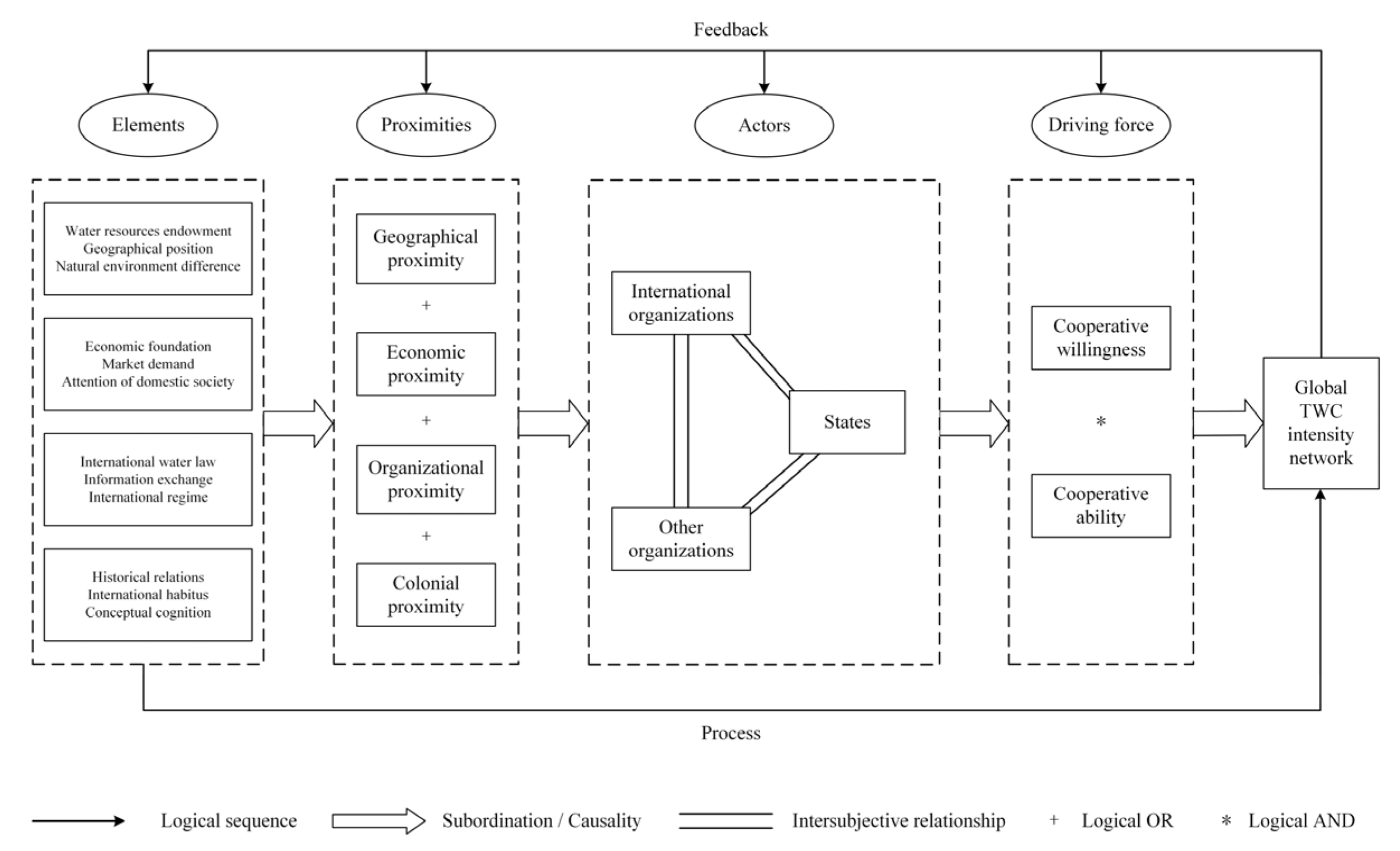
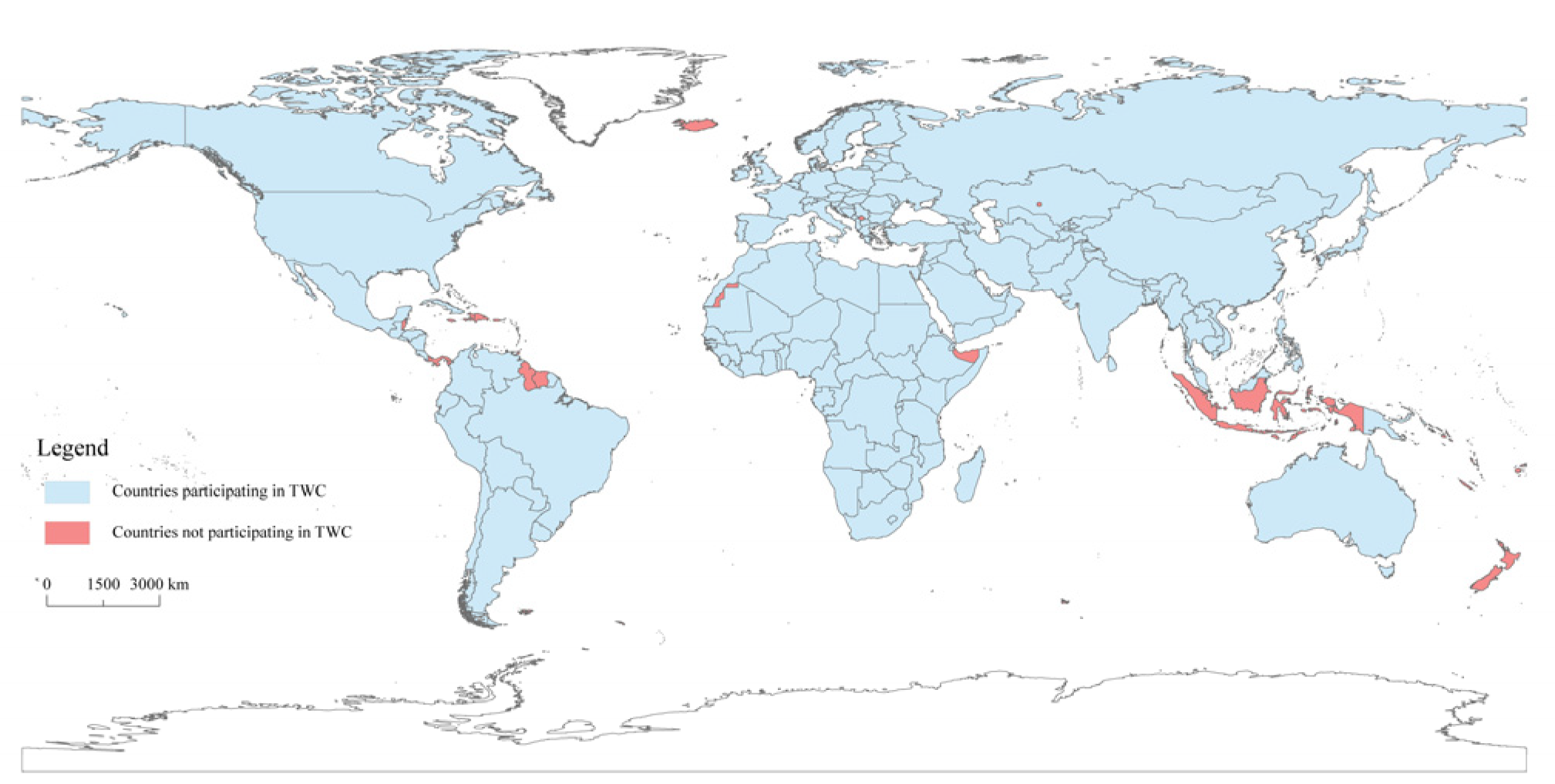
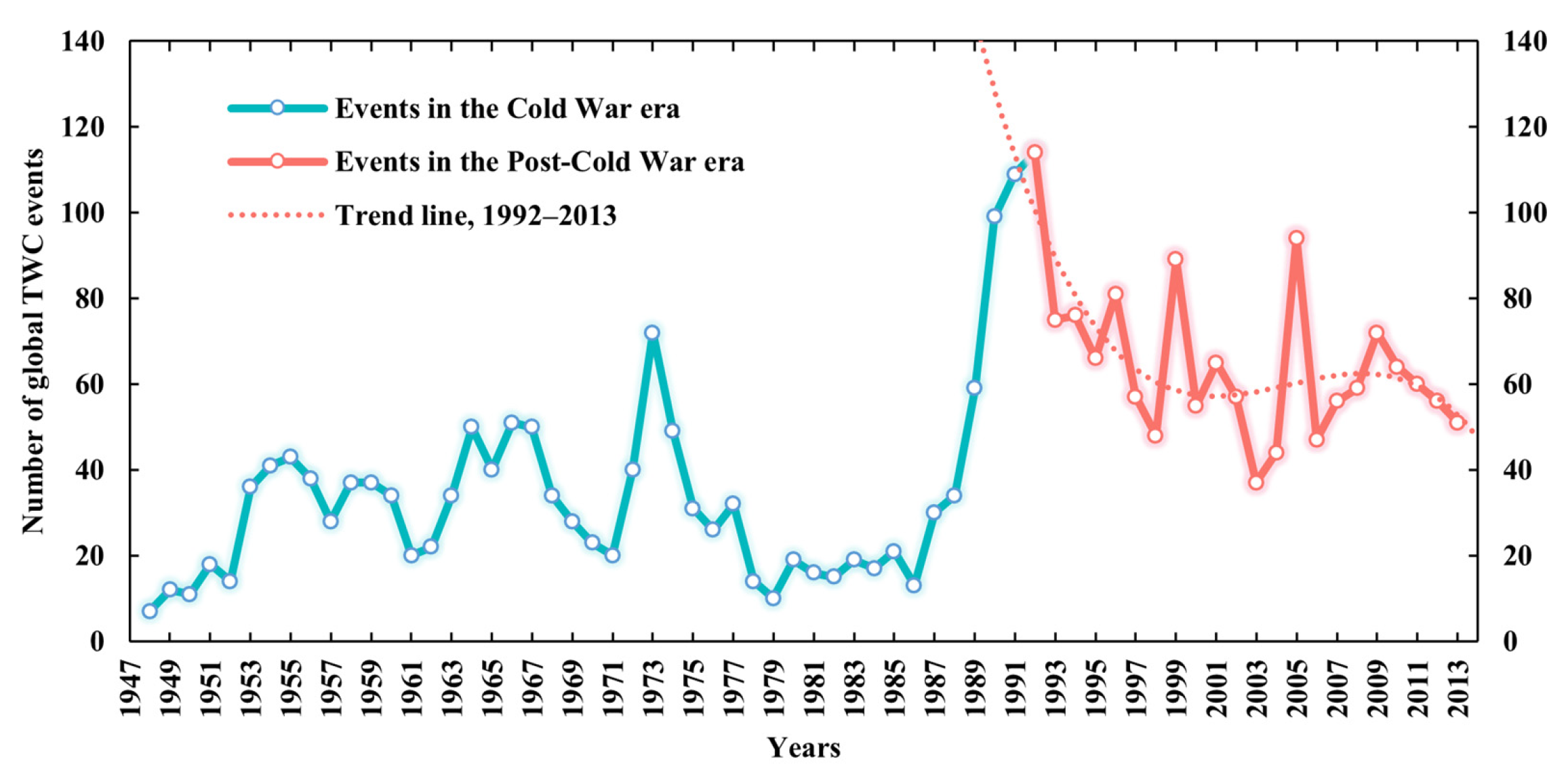
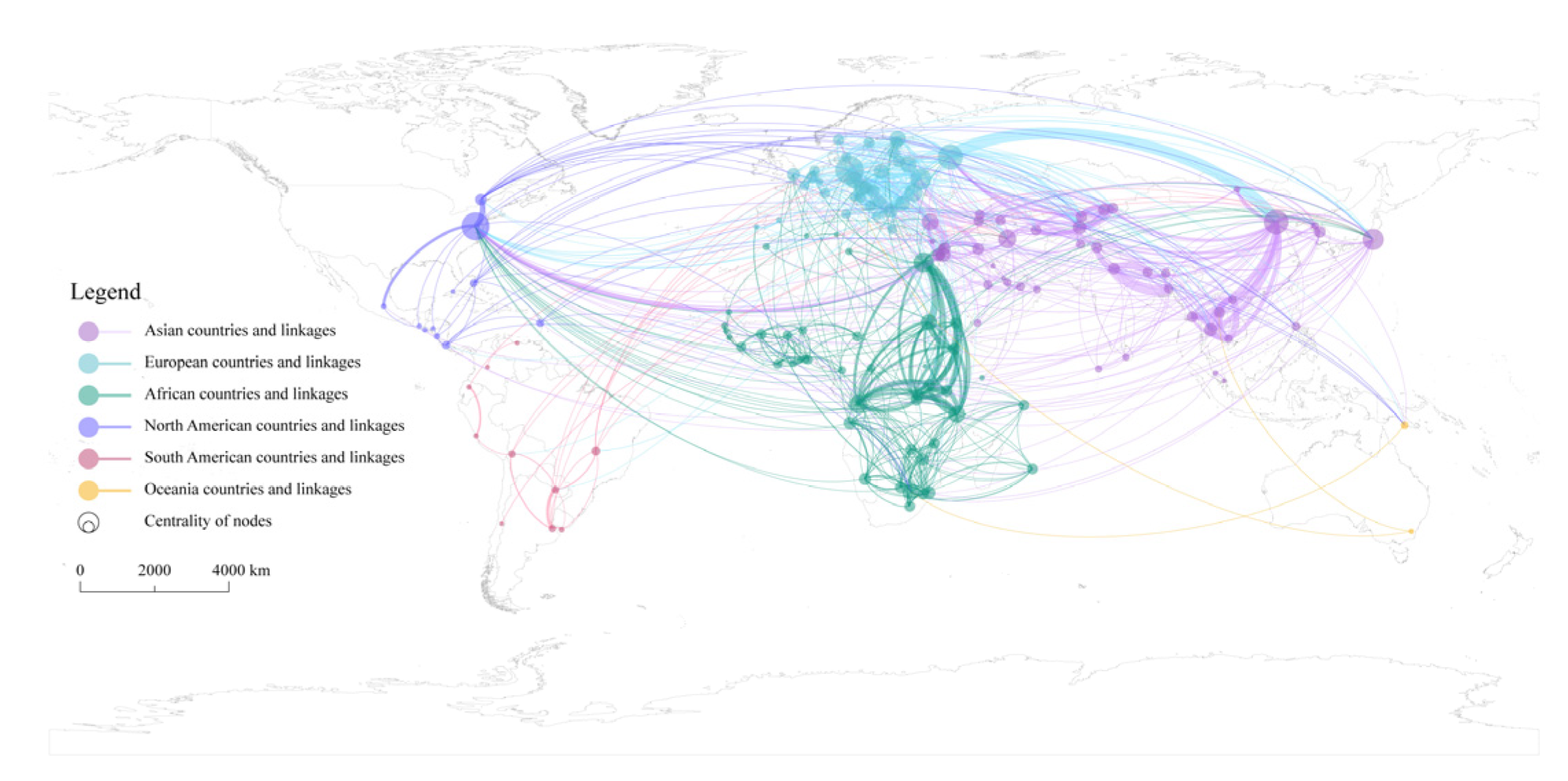
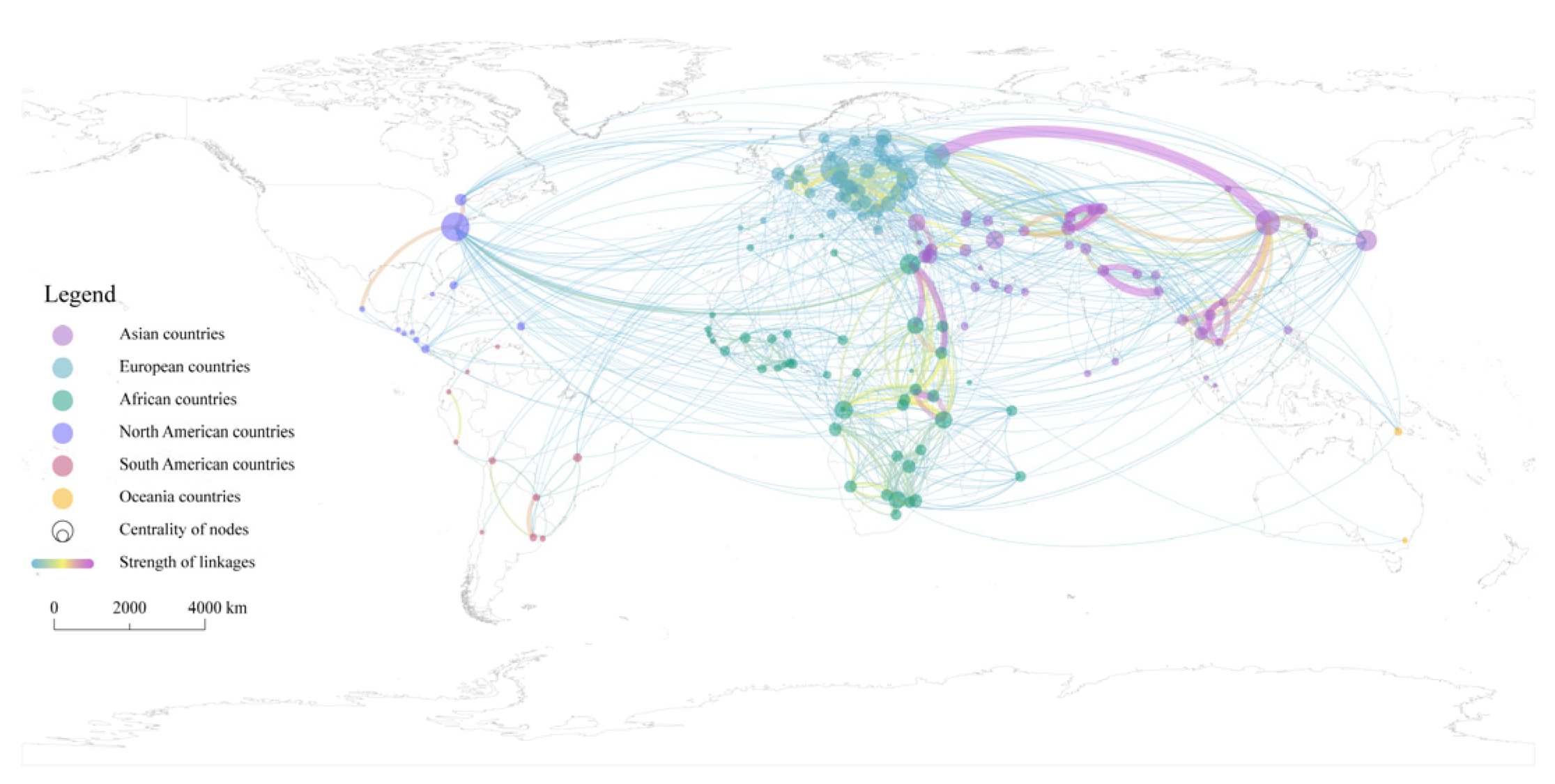
| Proximity Name | Indicator Name | Abbreviation | Definition | Source | Years |
|---|---|---|---|---|---|
| Geographical proximity | Geographical distance | dist | The geographical distance between the capitals of the two countries and standardize it | CEPII | 2019 |
| Same transboundary basin | basin | Dummy variable that is 1 if two countries belong to the same transboundary basin, and 0 otherwise | IWED | 2019 | |
| Economic proximity | Bilateral trade volume | trade | The cumulative value of bilateral trade volume between the two countries and standardize it | UNCTAD | 1992–2013 |
| Organizational proximity | Water organization | organ | The frequency that the two countries are in the same water organization | IWED | 1948–2013 |
| Colonial proximity | Colonial link | colony | Dummy variable that is 1 if two countries had a colonial relationship after 1945, and 0 otherwise | CEPII | 1945–2019 |
| Common colonizer | comcol | Dummy variable that is 1 if two countries had a common colonizer after 1945, and 0 otherwise | CEPII | 1945–2019 |
| Indicator | Formula | Definition | Implication |
|---|---|---|---|
| Degree | Number of nodes directly connected to node | The extent to which the actor is at the center of the network | |
| Weighted degree centrality | The ratio of the number of nodes directly connected to node to the maximum number of nodes that it may be directly connected. Weighted by the connection strength between nodes | The extent to which the actor is at the center of the network | |
| Weighted betweenness centrality | The standardized value of the probability that node is on the shortest path between node and node . Weighted by the connection strength between nodes | The extent to which the actor controls the contacts between other actors |
| Rank | Country | Weighted Degree Centrality | Country | Weighted Betweenness Centrality | Country | Weighted Degree Centrality | Country | Weighted Betweenness Centrality |
|---|---|---|---|---|---|---|---|---|
| 1 | China | 0.279 | China | 0.153 | China | 0.279 | China | 0.153 |
| 2 | Germany | 0.177 | Egypt | 0.052 | Germany | 0.240 | Germany | 0.068 |
| 3 | Russia | 0.171 | Germany | 0.050 | Russia | 0.200 | Russia | 0.050 |
| 4 | Egypt | 0.156 | USA | 0.045 | Ukraine | 0.138 | USA | 0.044 |
| 5 | USA | 0.121 | Russia | 0.043 | Egypt | 0.125 | Egypt | 0.042 |
| 6 | Ukraine | 0.111 | Sudan | 0.018 | Tanzania | 0.123 | South Africa | 0.022 |
| 7 | Tanzania | 0.106 | Iran | 0.017 | USA | 0.119 | Iran | 0.017 |
| 8 | Congo-Kinshasa | 0.095 | Congo-Kinshasa | 0.014 | Congo-Kinshasa | 0.091 | Sudan | 0.016 |
| 9 | Sudan | 0.088 | Japan | 0.013 | Moldova | 0.091 | Congo-Kinshasa | 0.014 |
| 10 | Moldova | 0.080 | Jordan | 0.013 | Sudan | 0.077 | Tanzania | 0.013 |
| 11 | Thailand | 0.071 | Turkey | 0.013 | Tajikistan | 0.077 | Japan | 0.012 |
| 12 | Turkey | 0.067 | Tanzania | 0.011 | Czech | 0.076 | Turkey | 0.011 |
| 13 | Ethiopia | 0.067 | South Africa | 0.010 | Romania | 0.075 | Jordan | 0.011 |
| 14 | Czech | 0.067 | Ukraine | 0.007 | South Africa | 0.067 | Mali | 0.009 |
| 15 | Romania | 0.064 | Israel | 0.006 | Thailand | 0.064 | Ukraine | 0.009 |
| 16 | Jordan | 0.063 | India | 0.005 | Bulgaria | 0.064 | Czech | 0.006 |
| 17 | Tajikistan | 0.059 | Czech | 0.005 | Kazakhstan | 0.060 | Poland | 0.006 |
| 18 | Bulgaria | 0.057 | Syria | 0.005 | Turkey | 0.059 | Zimbabwe | 0.006 |
| 19 | Kenya | 0.056 | South Korea | 0.005 | Ethiopia | 0.056 | Israel | 0.005 |
| 20 | Uganda | 0.055 | Laos | 0.005 | Hungary | 0.055 | Laos | 0.005 |
| Variable | Unstandardized Coefficient | Standardized Coefficient | p-Value | Standard Error |
|---|---|---|---|---|
| dist | −0.84635 | −0.03839 | 0.0005 | 0.24382 |
| basin | 13.32802 | 0.47452 | 0.0005 | 0.20493 |
| trade | 21.97590 | 0.09077 | 0.001 | 2.11566 |
| organ | 0.07188 | 0.04437 | 0.0005 | 0.01968 |
| colony | 1.43859 | 0.03712 | 0.001 | 0.29427 |
| comcol | 0.95653 | 0.05921 | 0.0005 | 0.14187 |
| Intercept | −1.00595 | 0 | 0 | 0 |
| 0.2722 | ||||
| 0.27199 |
Publisher’s Note: MDPI stays neutral with regard to jurisdictional claims in published maps and institutional affiliations. |
© 2022 by the authors. Licensee MDPI, Basel, Switzerland. This article is an open access article distributed under the terms and conditions of the Creative Commons Attribution (CC BY) license (https://creativecommons.org/licenses/by/4.0/).
Share and Cite
Yan, Z.; Qiu, X.; Du, D.; Grimes, S. Transboundary Water Cooperation in the Post-Cold War Era: Spatial Patterns and the Role of Proximity. Int. J. Environ. Res. Public Health 2022, 19, 1503. https://doi.org/10.3390/ijerph19031503
Yan Z, Qiu X, Du D, Grimes S. Transboundary Water Cooperation in the Post-Cold War Era: Spatial Patterns and the Role of Proximity. International Journal of Environmental Research and Public Health. 2022; 19(3):1503. https://doi.org/10.3390/ijerph19031503
Chicago/Turabian StyleYan, Ziming, Xiaojuan Qiu, Debin Du, and Seamus Grimes. 2022. "Transboundary Water Cooperation in the Post-Cold War Era: Spatial Patterns and the Role of Proximity" International Journal of Environmental Research and Public Health 19, no. 3: 1503. https://doi.org/10.3390/ijerph19031503
APA StyleYan, Z., Qiu, X., Du, D., & Grimes, S. (2022). Transboundary Water Cooperation in the Post-Cold War Era: Spatial Patterns and the Role of Proximity. International Journal of Environmental Research and Public Health, 19(3), 1503. https://doi.org/10.3390/ijerph19031503






